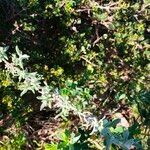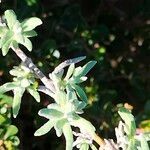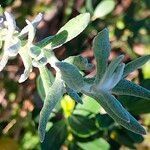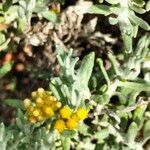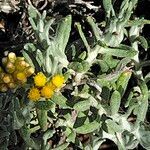Sprawling or tangled shrub, up to 2 m tall. Leaves often with axillary tufts, linear-lanceolate, mostly 10-40 mm long, slightly auriculate, revolute, glabrescent above, white-woolly beneath. Flowerheads in compact corymbs, disciform, campanulate, 4.5-5 mm long, bracts 4-or 5-seriate, oblong, rounded, straw-coloured, florets 20-40, female florets campanulate above.
Sprawling, thinly grey-woolly shrub to 2 m. Leaves often in axillary tufts, linear-lanceolate, slightly auriculate, revolute, glabrescent above, white-woolly beneath. Flower heads disciform, in compact, terminal corymbs, campanulate, straw-coloured, ± 5 x 4 mm, florets 20-40, ovary papillate-hairy.
